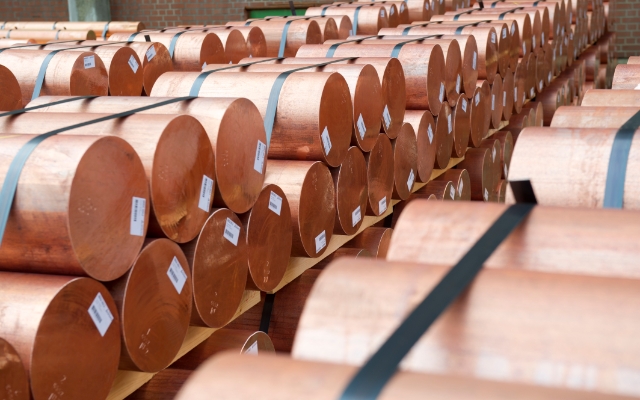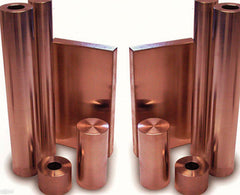Checking Out the Diverse Applications of Copper Products in Modern Industries
From boosting the performance of electric systems to playing a vital role in sustainable energy modern technologies, the versatility of copper is noticeable. As industries increasingly prioritize innovation and sustainability, the diverse applications of copper call for a closer exam, specifically concerning their prospective effect on future technological innovations and environmental practices.
Electric Applications of Copper
Copper is a crucial product in the electric market, representing approximately 60% of the total need for non-ferrous metals globally - Copper Products. Its remarkable electric conductivity, which is almost two times that of light weight aluminum, makes it the preferred selection for a wide variety of electrical applications. From wiring systems in industrial and property structures to high-voltage power transmission lines, copper guarantees performance and dependability in power delivery
Along with wiring, copper is important to the manufacturing of electric components such as generators, electric motors, and transformers. These components leverage copper's thermal conductivity and malleability, important for warm dissipation and effective performance. Moreover, copper's resistance to rust boosts the life expectancy and sturdiness of electrical systems, making it an affordable remedy in the long-term.
The growth of renewable resource sources, such as solar and wind power, has actually even more boosted the need for copper in electrical applications. As industries shift towards lasting energy services, copper's function comes to be much more crucial. Generally, the convenience and performance characteristics of copper strengthen its status as a keystone product within the electric industry, driving innovation and efficiency across numerous applications.
Plumbing and Piping Solutions
In contemporary plumbing systems, the option of materials substantially influences both performance and durability. Copper has become a recommended alternative because of its unique properties, consisting of deterioration resistance and antimicrobial qualities. These attributes make sure that copper piping remains long lasting and risk-free for carrying drinkable water, a vital consideration in property and commercial applications.
Among the key advantages of copper in plumbing is its capability to hold up against high temperatures and stress, making it suitable for a variety of applications, from warm water systems to heating and cooling down networks. Additionally, copper's adaptability enables for less complicated setup in complicated piping designs, decreasing the threat of leakages and failings.
One more noteworthy advantage is copper's long life-span, commonly exceeding 50 years with appropriate upkeep. This long life not just decreases substitute costs but likewise adds to lasting methods by minimizing waste. Moreover, copper's recyclability lines up with contemporary ecological criteria, advertising a round economic climate within the plumbing sector.
Copper in Renewable Resource
The convenience of copper extends past pipes applications, playing an important function in the sustainable power market. In solar panels, copper is used in photovoltaic cells and electrical wiring, promoting effective energy conversion and transmission.

Furthermore, as the international need for electrical vehicles (EVs) rises, copper's duty in battery systems and billing framework comes to be also extra substantial. The material's capability to carry out power efficiently is essential to the efficiency of EV batteries, enhancing range and charging speed.
Copper's Duty in Electronics
Electronic devices producing depends heavily on copper's remarkable residential properties, specifically its high electrical conductivity and thermal effectiveness. These qualities make copper an optimal choice for a variety of electronic parts, consisting of connectors, circuit boards, and circuitry. The metal's capability to successfully transmit electric signals guarantees minimal energy loss, which is essential in high-performance electronic gadgets.
Furthermore, copper's thermal conductivity plays a significant role in warmth dissipation, safeguarding delicate components from overheating. This is especially essential in modern electronics, where small layouts cause see this here enhanced heat generation. Copper is also favored for its malleability and ductility, allowing it to be easily formed into detailed layouts that fulfill the needs of innovative digital applications.
With the surge of basics consumer electronic devices, telecoms, and electric vehicles, the demand for copper in the electronics market proceeds to grow. Thus, copper stays a foundation material in the ever-expanding area of electronics.
Cutting-edge Makes Use Of in Production

One noteworthy application is in additive manufacturing, where copper-based materials are utilized in 3D printing processes. This permits for the production of complex geometries and lightweight parts, especially in the aerospace and auto sectors. Additionally, copper's thermal conductivity makes it an excellent option for warmth exchangers, enhancing efficiency in commercial cooling systems.
Moreover, the surge of clever production has actually seen the consolidation of copper in IoT gadgets, where its conductive abilities support advanced sensing technologies. In the realm of renewable resource, copper is crucial in the production of photovoltaic panels and wind generators, promoting much more effective energy conversion and circulation.
As industries pursue sustainability and technology, copper's flexibility and performance continue to position it as an essential product, driving innovations in production and contributing to the advancement of smarter, more efficient products.
Verdict
The essential duty of copper in eco-friendly power and its important feature in electronic devices underscore its relevance in advancing lasting methods. Jointly, these applications show copper's critical payment to technological development and commercial performance in contemporary society.
From enhancing the effectiveness of electrical systems to playing a critical role in sustainable power technologies, the convenience of copper is apparent. As sectors progressively prioritize development and sustainability, the varied applications of copper require a closer assessment, specifically regarding their possible influence on future environmental methods and technological advancements.
The growth of sustainable energy resources, such as solar Continued and wind power, has actually better boosted the need for copper in electric applications. In general, the adaptability and performance attributes of copper solidify its status as a foundation material within the electric sector, driving technology and effectiveness throughout different applications.
The flexibility of copper expands beyond pipes applications, playing a crucial duty in the renewable energy field.
Comments on “The Ultimate Guide to Sustainable Coping With Eco-Friendly Copper Products”